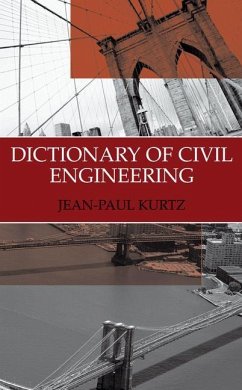This English version of the French publication, (Dictionnaire du Génie Civil, published by the Conseil International de la Langue Française in 1997) will be a valuable reference tool for civil engineers. There are over 12,000 definitions accompanied by more than 1,300 charts, tables, and graphs. This dictionary is a comprehensive compilation of definitions, examples and descriptions - from the study of soils, and the various materials and equipment used, including the most common architectural terms as they relate to civil engineering. The clear and concise presentation of this dictionary will easily clarify often confusing concepts and correct other lexicological errors. This compendium will be an invaluable tool not only for civil engineers, but also for lawyers, contractors, engineering and design departments, architects, etc. and all trade associations involved with this discipline. This dictionary may also be used as a valuable teaching tool.
I am pleased to present a work which marks a milestone in the history of public works and, more precisely, in that of permanent structures-a comprehensive dictionary of Civil Engineering terms. Since the beginning of time, Man has always tried to find a means to clear the obstacles which nature erected to displace him. With the first tree trunk thrown across a river, man sought to improve the crossing structure. After the invention of the wheel, and to satisfy his thirst for conquest (Roman ways), and comfort (aqueducts), man built bridges that became a preremptory necessity to move quickly. Thus, Man started to build wooden and masonry works. With the passing centuries, the builders became masters in the art of building masonry works. Then came the Industrial Revolution and the advent of the steel (1864), which was closely followed by the invention of the reinforced concrete (1855). The need for railways and improving the road network inspired great works of crossing such as viaducts and tunnels. The boom of the railway network and the development of the car required the construction of an increasing number of new structures. This phenomenon continues today with hundreds of structures built each year throughout the world.
Hinweis: Dieser Artikel kann nur an eine deutsche Lieferadresse ausgeliefert werden.
I am pleased to present a work which marks a milestone in the history of public works and, more precisely, in that of permanent structures-a comprehensive dictionary of Civil Engineering terms. Since the beginning of time, Man has always tried to find a means to clear the obstacles which nature erected to displace him. With the first tree trunk thrown across a river, man sought to improve the crossing structure. After the invention of the wheel, and to satisfy his thirst for conquest (Roman ways), and comfort (aqueducts), man built bridges that became a preremptory necessity to move quickly. Thus, Man started to build wooden and masonry works. With the passing centuries, the builders became masters in the art of building masonry works. Then came the Industrial Revolution and the advent of the steel (1864), which was closely followed by the invention of the reinforced concrete (1855). The need for railways and improving the road network inspired great works of crossing such as viaducts and tunnels. The boom of the railway network and the development of the car required the construction of an increasing number of new structures. This phenomenon continues today with hundreds of structures built each year throughout the world.
Hinweis: Dieser Artikel kann nur an eine deutsche Lieferadresse ausgeliefert werden.
From the reviews:
"This is a comprehensive dictionary of terminology used in civil engineering. ... Clear, concise definitions are accompanied by more than 1,300 graphics arranged at the end of each letter of the alphabet. A list of synonyms follows each entry to indicate cross-references. ... this dictionary would be an excellent desk reference for practicing engineers, architects, technicians, contractors, and tradespeople." (J. A. Buczynski, CHOICE, Vol. 42(7), March, 2005)
"This is a comprehensive dictionary of terminology used in civil engineering. ... Clear, concise definitions are accompanied by more than 1,300 graphics arranged at the end of each letter of the alphabet. A list of synonyms follows each entry to indicate cross-references. ... this dictionary would be an excellent desk reference for practicing engineers, architects, technicians, contractors, and tradespeople." (J. A. Buczynski, CHOICE, Vol. 42(7), March, 2005)








